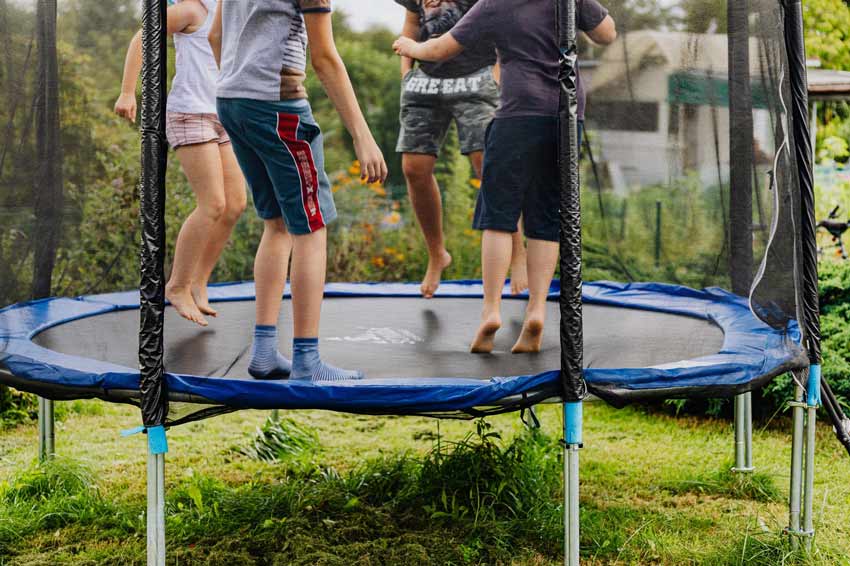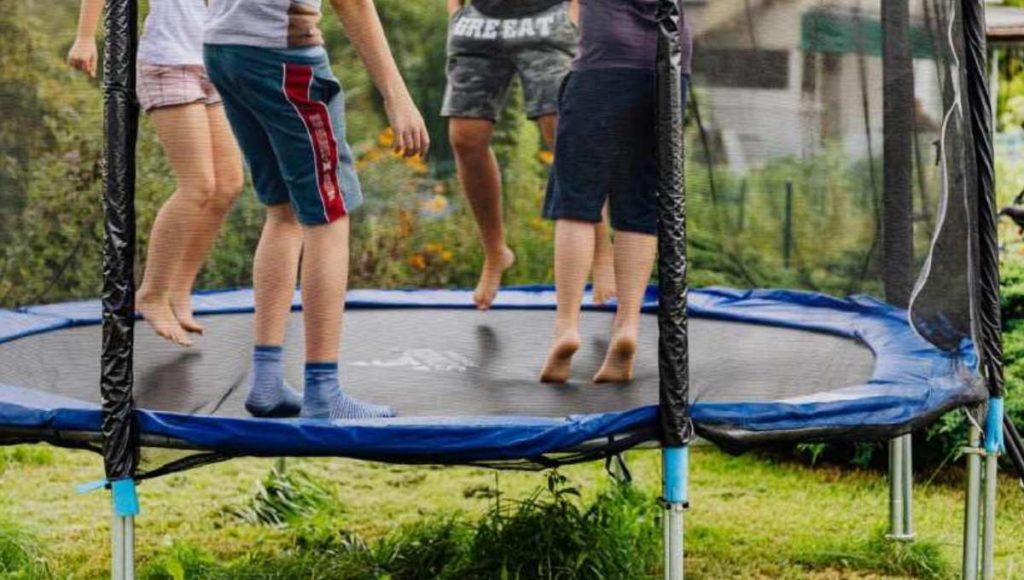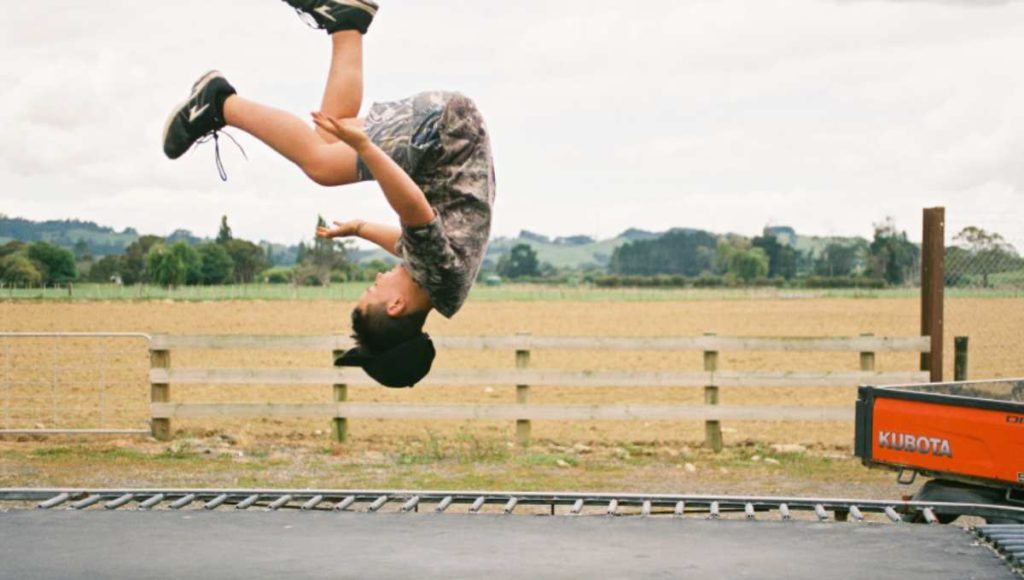So the question is trampoline good exercise or not? The clear answer is, yes it is. But to get the desired health benefits, you have to know what you’re doing first. In this article, I’ve put together a few interesting and easy trampoline exercises for you.
I also categorized exercise tips into mini rebounder and full-sized trampolines. Also, you’ll find here the age recommendation with beginners, and adult exercise classification pretty helpful.
Also, I have written in-depth best mini trampoline reviews based on real user experience. Which you can choose for yourself and your kids.
- Is trampoline good exercise? Let's find out how to get the benefits
- Exercises for large trampolines
- Some rebounding exercises for seniors
- Simple trampoline exercises for adults
- Conclusion
A trampoline is a portable way to exercise and reap the health benefits that you would get from performing high-impact outdoor activities.
Regular rebounding exercise on a trampoline will promote cardiovascular health, joint and muscle strengthening, increased motor skills, coordination, and overall balance of your body. Even if you just spend 15 minutes on your trampoline then it will change your body shape instantly.

Is trampoline good exercise? Let’s find out how to get the benefits
A trampoline is an excellent way to exercise and get amazing health benefits.
It’s so good that 10 minutes trampoline equivalent health benefits as 40 minutes of jogging.
You won’t find any other low impact exercise that offers so many benefits in return. But to get those health perks, you have to know how to rebound on a trampoline properly.
We’ve categorized our work out tips based on age and trampoline types. Hope you’ll find them worth your while.
Exercises for large trampolines
Large trampoline is one of my most favorite trampolines. It helps me to keep active as a father and also my kids are heavily enjoying the view of it.
If you are interested to know more about the large trampoline based on user experience then check out this awesome review Best 16ft large trampolines make your backyard enjoyable.
Here you can also take a look at this quick large trampoline exercises Video for more fun and Active game.
1. Standard vertical jump
Also called the straight jump, you just need to bounce straight up and down without losing balance. Please make sure that you are landing on the anticipated spot. A lot of trampoline accidents occur when the jumper loses concentration and ends up landing awkwardly.
How to do vertical jump on a trampoline?
- Relax and start slow
- Start to increase your vertical leap
- Use both hands to an upward swimming motion for elevation and balance
- Watch where you are landing every time
- Try not to land on the edge of the trampoline unless you want to bounce out of the trampoline
- There’s no time limit on how long you should jump. But doctors recommend that you shouldn’t jump on a trampoline for more than 25 minutes at once.
2. Tuck jumping
Tuck jumping is also known as the knee tuck jumping. It’s a very effective aerobic exercise for inside and outside of a trampoline.
How to tuck jump on a trampoline?
- Keep your feet a little apart than your shoulder length
- Now do a half squat stance and jump into the air
- Keep your knees loose so you can regain that half-squat stance once you land.
- Take it slow for the first couple of jumps. Once you get the hang of it, try jumping higher.
- Do this for a maximum of 3-5 minutes
3. Hands and knees bouncing
Both hands and knees jump is good for your flexible joints and strengthening those fragile tendons. The purpose of this trampoline exercise is to use your hands and knees for rebounding. Also toning your thin muscles for better body balance and weight support.
How to do hands and knees bouncing properly?
- You have to jump up vertically. Just a standard jump will do.
- But when you are coming down, make a cat-like posture. Or you could call it like a skydiving posture.
- Make sure you make the impact on the trampoline with your forearms and knees.
- Once you bounce on these body parts, you’ll be back to your standard jumping stance.
- Repeat the process all over again for 2-4 minutes top.
4. Pike jumping
Pike jump isn’t suitable for everyone. Those who have veins, muscles, and nerve damages shouldn’t perform this jump at all. Pike jumps are considered to be a high-impact exercise.
Because the way you loft your legs In front of you horizontally in the mid-air. And then your feet kinda crags land on the ground making an intense impact on your knees and lower back. But on the trampoline though, it’s a whole other story.
For more you can check out our other two helpful article:
Pike jumps are excellent for strengthening core muscles and your butt muscles. Those who live a sedentary life should do a set of pike jumps on the trampoline.
Please note that you don’t have to touch your toes with your hand in mid-air from the beginning. Take your time and slowly your muscle will get relaxed and flexible.
How to pike jump on a trampoline?
- Again start by leaping vertically.
- Once you are in mid-air, slowly lift our legs in front of you as straight as possible.
- Keep both legs locked together for balance and better aerodynamics.
- Try to reach and touch your toes in the mid-air.
- Go back to a straight stance once you’re coming down on the trampoline.
5. Tuck Jump
Another exciting trampoline exercise is the tuck jump. This exercise focuses on your core. Please note that tuck jumps are difficult to do on the ground. Yet one of the easiest exercises on the trampoline.
How to tuck jump on a trampoline
- Jump as high as possible. You may need to jump a couple of times to start the tuck jumps effectively.
- Once you have gained the momentum, try to bring your knees closer to your chest to imitate a tucking position.
- You can grab your knees to get a little hand time in mid-air. It also increases balance.
The tuck jumping on a trampoline is one of the most effective exercises to lose a ton of weight. Try to push your knees closer to your chest for more intense core workouts.
6. Squat jumping
I didn’t want to include the squat jumping in the large trampoline section. But I think you’ll be more comfortable to do squat jumping on a large trampoline rather than on a mini-trampoline. Besides squat jumping on a large trampoline is safer and you can intensify your momentum to the maximum.
How to squat jump on a trampoline?
- Keep your feet under your hips and your arms close to your body.
- Once you jump and elevate, take your feet in a wider sideways position compared to your hip.
- Land on the trampoline with a squat position.
- Before you bounce back up, keep your thighs and bend your knees parallel to the trampoline surface.
- Keep your arms stretched in front of you.
- And then rebound up to another jump.
- Keep doing the squat jump for 2-3 minutes per day.
7. Seat landing/ Seat drop
Beware, if you at the type of back issues like pinched nerves, fractured broken, or injured coccyx bones, disc problems, don’t try the seat landing.
The main purpose of the seat drop exercise on a trampoline is to bounce with your butt. If you are healthy enough, this exercise will strengthen your pelvic floor muscle and butt muscles.
How to seat drop on a trampoline?
- Slowly bounce and gain some momentum.
- Once you are ready, extend your legs and arms in mid-air.
- Just before impact, keep your palms down to embrace the impact and keeping the balance. But keep your legs in that horizontal position in Infront of you.
- The bottom line is, you’ll be landing on your palm and butt.
- Please try not seat drop continuously If it’s your first time.
- It’s not necessary to gain momentum. You can just fall backward keeping your legs straight to do a seat drop.
- Just relax and do the seat landing as long as you feel comfortable. But I don’t recommend doing it more than 5 minutes a day.
8. Twisting
Don’t get any ideas about B twisting. Unless you are a gymnast it’s never a good idea to B twist. Twisting jumps on a trampoline can be performed in different forms. You can just causally jump up and twist at either side.
Or you can drop backward and upon rebounding, you can drop back again and again. Just know that the twisted jump is dangerous for senior people and those who aren’t used to be on a trampoline.
How to twist on a trampoline?
- Stand still with arms close to your body and slowly get momentum.
- Rotate your body on the left or right before landing Gon the trampoline surface.
- You can do reverse twists by turning your upper body to the left or right and at the same time your lower body on the opposite side.
- Do this as long as you feel up for it. Although I recommend 3 minutes is sufficient for a day.
9. Butt kicker jumping
The main purpose of this exercise is to kick your butt on a trampoline, literally. You have to bend your knee backward in the mid-air so much that the heel can touch or get close to touching your butt cheek.
The benefit of doing the butt kick jump is stronger glute, leg, and thigh muscles. I’d suggest doing the butt-kicker jump on a trampoline rather than on the ground.
But if you choose to do it on the ground, please try to wear full gel sneakers to reduce the impact on your knees and lower back.
How to do butt-kicker jump on a trampoline?
- You can do this in two ways. One is a single heel and the other is the double heel butt kick.
- For a single heel, you have to do a jogging motion from a fixed spot.
- And for double butt kicks, jump higher and bend your knees to bring those heels closer to your keisters.
Some rebounding exercises for seniors
For Quick recap you can take a look at this awesome 5minutes rebounding exercise for seniors.
Trampoline offers lots of health benefits, especially for seniors. A recent trampoline for weight loss reviews suggests that elders are more likely to achieve a linear body more easily from trampolining.
Let’s find out what type of trampoline exercises are best suitable for senior citizens.
1. Standard jogging
Jogging on a trampoline is an easy and effective way to get some workout done from your home. You have to do a running motion from a fixed spot on a trampoline.
How to jog on a trampoline?
- Start by running while staying in a single spot.
- You can move your hand in a circular motion as you would have done If you were running on the ground.
- Or you can place both your hand on your hips and lean backward while doing a left and right army parade.
- Keep the exercise duration no more than 4 minutes a day.
2. Standard vertical jumps
Anyone at any type of physical shape and age can do vertical jumps. Even if you don’t mix up your trampoline exercises, simple vertical jumps still have enough health benefits.
How to do a standard jump?
- Stand still on the trampoline.
- Slowly start to bounce.
- Make sure that you have proper balance.
- You can move both hands in a circular motion to gain more elevation. I shouldn’t have to point it out because it will be instinctive.
Simple trampoline exercises for adults
Is trampoline cardio good enough to replace jogging, running, hiking, and even swimming? Folks who are still puzzled by this question should see these amazing health benefits of rebounding.
So, if you just bought your first trampoline and don’t know what to do with it, allow me to simplify with a few simple yet effective exercises.
1. Try mixing up your jumps
On the trampoline, there’s no limit and possibilities of things you can do. You can start slow by jumping up and down. Then switch to do some jumping jacks. Get creative and do some jogging variations.
How to do it?
- Use the bounce to jump from one spot to another.
- You can do some light running all over the trampoline
- If you’re up for it, do some squats in the mid-air and a few while standing on the trampoline surface.
- How about a few single-leg squats? They are excellent for upgrading coordination and promoting better circulation in your legs.
2. Bounce on a single leg
Single leg bounce is another excellent way to improve your coronation. It will train your leg muscles to support your body weight and in time increase insurance, stability, and strength.
Folks who sit on the desk for a long time should start this exercise to avoid developing varicose veins.
How to bounce on a single leg
- Take a stance with wider hips.
- Now pick one leg up and start rocking with the other leg.
- Make sure the weight of your body is centered in the middle of your sole.
- Keep jumping on each leg for a couple of minutes. That should be enough to tone up your leg muscles within weeks.
3. Knee thrust
Again an amazing exercise to strengthen your knee joints, hips, and cores. And it’s perfectly safe to perform on a full-sized trampoline. You can do the single knee thrust on a mini-trampoline. Just be sure to grab some safety trampoline equipment to avoid injuries.
How to do the knee thrust on a trampoline?
- To do the single knee thrust, you have to shift your body weight at the rear of your sole.
- Now slowly lift your preferred leg to a horizontal position. Ttyl to keep your thigh parallel to the floor for maximum effect.
- Once the lifted toe is at the similar height of your other knee (on the leg you are currently standing on) and your back is flat, try to back kick as far as you can. It’s like a giraffe back kicking a lion. Only in your case, the focus should be on balance and control rather than generating the velocity.
- Now do both legs for 1-3 minutes each.
4. Rapid footwork
Those who are still skeptical about whether trampolining is as effective as jogging, cycling, and running should try the rapid footwork.
You’ll need a sudden burst of energy to jog on a trampoline as fast as you can. I suggest not trying this right away on a mini-trampoline. Especially if you are not used to it.
How to do the rapid footwork on a trampoline?
- Slowly do the soldier parade.
- Now contour your body slightly inwards by squeezing your core muscles.
- Once you are all set, now start sprinting as fast as possible.
- Try to keep your hip parallel to your feet.
- You can do it only for a few seconds. So do it in sets. Each day, 5-7 sets are enough to reap some incredible health benefits such as better cardio and leg strength.
5. Straddle jump
Some folks will get goosebumps to even think about straddle jumping in the ground. Yet it’s a breeze on a trampoline. But don’t even think about straddle jumping on a mini rebounder. The risk involved is not worth the benefits.
How to do the straddle jump on a trampoline?
- First, you’ll have to gain momentum by jumping high.
- Once you are comfortable, try to spread your legs sideways, away from your hip position.
- It’s like spreading your legs apart while doing the tuck jump.
- Once you made the spread, try to touch the tip of each toe with your hands.
- Touching the toe isn’t mandatory. It’s the motion of our body that helps with increased mobility, strengthening the hip joints, and other amazing health benefits.
Conclusion
Folks who are still wondering is trampoline a good exercise or not, should go through the entire post one more time. Like any other physical activity, rebounding does have some flaws and safety concerns. So does eating your next hot dog.
Trust me when I say this, the benefits of rebounding are way better than those drawbacks.
I hope our exercise categorization of seniors, adults, and beginners depending on the trampoline type will help you a great deal. So, get yourself a trampoline and start living a healthy life. Cheers!





